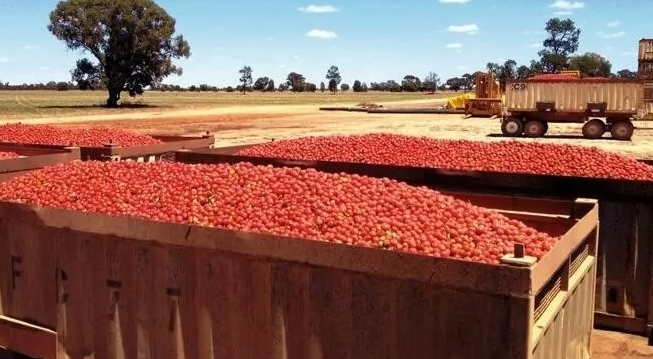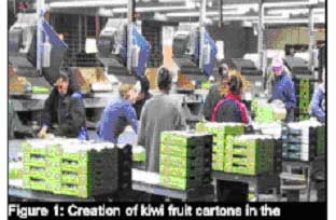
SICK radio frequency identification (RFID) fruit and vegetable automatic picking and intelligent identification program
[ad_1]
Many people love delicious and nutritious tomatoes-eaten as fresh fruit, tomato juice or with pasta. Approximately 20 million Australians consume 22 kg of processed tomatoes per capita each year. KAGOME, a Japanese tomato processing company founded in 1899, claims that it has more than 100 years of history in the field of tomato planting and processing. Since 2010, the KAGOME Australia plant in Echuca has begun to grow and process tomatoes, supplying high-quality tomato products to food companies in Australia and other countries. SICK radio frequency identification (RFID) technology enables KAGOME to ensure product traceability and greatly improve the efficiency of the production process.
According to the Australian Food and Daily Necessities Association (AFGC) website, “In the production and sales of food and daily necessities, protecting the health and safety of consumers is the most basic requirement, and it is also a statutory obligation of all related companies.” Quality control covers KAGOME The entire process from tomato seed management, crop growth to product launch. By minimizing the use of agricultural chemicals and maximizing natural pollination, we ensure that each tomato grows in the most environmentally friendly way for people, for the crop itself, and for the environment. Nowadays, how to automate tomato picking and processing is an urgent problem, and how to transport tomatoes from the field to the factory floor in the most efficient way is a logistics challenge.
Looking for automated identification solutions
In Echuca’s fields, KAGOME uses 12 harvesters to pack tomatoes into more than 300 large wide-mouth boxes with a capacity of 14 tons. Each box full of fresh tomatoes was unloaded onto the mat, waiting for a truck (12 in total) to transport it to a weighbridge near the factory. It takes about 90 minutes from the field to the KAGOME factory, and each truck can transport three boxes at a time-which means that each truck can transport approximately 42 tons of tomatoes at a time. Three years ago, there was always a long queue of trucks near the weighbridge, and the driver had to wait 12 minutes before he could get out of the truck to weigh the tomatoes. As part of KAGOME’s quality control process, three samples must be taken from each box and tested in the laboratory to determine whether the tomatoes really came from KAGOME’s farm. In addition, the driver must prepare relevant documents to record the picking process, output and quality. This process increases the possibility of human error in the document-based quality control system, which may allow contaminated products to reach consumers, thereby greatly increasing the chance of widespread disease transmission due to food. Therefore, in order to ensure traceability, KAGOME Australia began to look for a solution that can realize paperless automatic identification of weighbridges.

Ensuring traceability: what is the best tomato identification scheme?
Food traceability refers to the process of tracking the history of a product and sharing this data throughout the processing process-the so-called “farm-to-table” program. Although traceability has always been the top priority of the food and beverage industry, the demand for real-time recalls in Australia has been increasing in recent years (because of factory processing errors or FSANZ implementation of product recalls by the Australia New Zealand Food Standards Authority) . Under ideal circumstances, there is no need for product recalls; however, once a recall event occurs, eliminating the impact as much as possible is the focus of every food manufacturer’s compensation plan. An effective tracking and tracing system includes multiple parts. The first part is accurate and fast identification. For many years, the main force of recognition has been the ubiquitous barcode. Throughout the production process, the food can be identified by a unique barcode; the barcode can be affixed to the container during processing, the packaging of the finished product, the box and pallet during transportation, and the shelf of the final retail store. KAGOME experts are looking for real-time identification solutions that can cope with the environment such as soil, tomato juice, high temperature, wind and rain.
Simplify the picking process with radio frequency identification (RFID)
With the continuous development of radio frequency identification (RFID) technology and the gradual decrease in cost, its application in food tracking has become more and more extensive. Applications in large raw material containers and bulk mixed materials are very common. It provides companies with a variety of ways to simplify and manage related processes, especially in terms of traceability and process reliability. Wireless identification technology has opened up new areas for automatic data recording. Radio frequency identification (RFID) technology has been used in the automotive industry for many years. After a label is attached to the car body, the data of each car can be written into it through encoding. Radio frequency identification (RFID) tags can provide more functions than barcode technology because they can be read/written directly without visual contact with the tag. In addition, they are also very sturdy and durable, so they can withstand harsh environmental conditions such as high temperature, dirt or humidity.
SICK Australia’s industry sales manager Jean-Michel Maclou and sales engineer Christian Herr showed the RFU63x read/write device to KAGOME in 2012. The device can be used as an ultra-high frequency (UHF) radio frequency identification (RFID) solution for tracking and tracing reusable containers, while also providing batch inspection capabilities. In addition, RFU63x can also be used as an independent working intelligent system. Integrated functions such as data processing and filtering can ensure stable reading performance and short reading cycles. In January 2013, KAGOME installed six SICK RFU63x equipment in Echuca’s floor scale and unloading area, each equipped with three antennas for double-layer cargo containers. The radio frequency identification (RFID) tag fixed to the tomato container has strong tolerance and good stability, and will accompany it from the beginning of the picking process. RFU63x fully meets KAGOME’s need for paperless automatic identification of tomatoes. In this way, radio frequency identification (RFID) technology can be used to avoid errors that often occur during the entry and exit of goods, such as inaccurate quantity and quality data and missing accounts.

The SICK RFU63x reader does not need to have visual contact with the RFID tag
Radio Frequency Identification (RFID) can identify the source of tomatoes in real time. In the paperless identification process, truck drivers no longer need to get off at the weighbridge, thereby improving their safety. Trucks spend less time on the floor scales, and the long truck queues at the floor scales and in front of the tomato unloading area are also a thing of the past, and the transportation efficiency is greatly improved. In view of the fact that the time the truck needs to spend on the weighbridge has been reduced from the previous 12 minutes to 2 minutes, the truck driver can make one more trip in every 12-hour rotation.
Assuming that there are 12 trucks in the fleet, and each truck can load an average of 42 tons of tomatoes, the use of new radio frequency identification (RFID) technology can increase productivity by 504 tons. With more reliable real-time data brought by SICK’s intelligent identification technology, KAGOME not only gains the ability to make the best decisions, but also greatly improves productivity and efficiency.
[ad_2]




